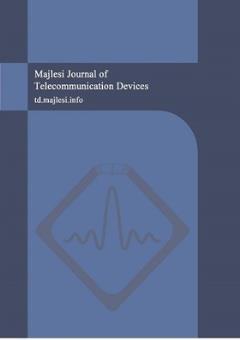Distributed Jammer-Equipped Target Tracking with Hybrid Extended Kalman and Particle Filter in Sensor Network
محورهای موضوعی : Majlesi Journal of Telecommunication DevicesIman Maghsudlu 1 , Meysam Raees Danaee 2 , Hamid Arezumand 3
1 - Phd Candidate of Electrical Engineering, Faculty of Electrical Engineering, Imam Hossein University, Tehran, Iran
2 - Assistant Professor, Faculty of Electrical Engineering, Imam Hossein University, Tehran, Iran
3 - Researcher, Faculty of Electrical Engineering, Imam Hossein University, Tehran, Iran
کلید واژه: Distributed Particle Filter, Sensor Network, Multi-Sensor Target Tracking, Data Fusion, Consensus-Base Algorithms,
چکیده مقاله :
In this paper, we propose a distributed tracking algorithm for a jammer-equipped target that passes through the nodes of a wireless sensor network (WSN). The jammer that the target carries is of the deceptive type, which means that it can mimic the signal of the target and confuse the sensors. Unlike other existing methods, our proposed algorithm does not require any additional hardware installation on each WSN node. It only relies on signal processing and solving the average consensus problem to detect the presence of jamming effects in the observations of the contaminated nodes and exclude them from the distributed tracking problem. For the distributed tracking problem, we use the hybrid extended Kalman filter (EKF) and particle filter to reduce the number of parameters needed for solving the average consensus problem and to decrease the communication overhead. The simulation results show that our algorithm improves the tracking performance compared to the case where the nodes with jammed observations are used.
In this paper, we propose a distributed tracking algorithm for a jammer-equipped target that passes through the nodes of a wireless sensor network (WSN). The jammer that the target carries is of the deceptive type, which means that it can mimic the signal of the target and confuse the sensors. Unlike other existing methods, our proposed algorithm does not require any additional hardware installation on each WSN node. It only relies on signal processing and solving the average consensus problem to detect the presence of jamming effects in the observations of the contaminated nodes and exclude them from the distributed tracking problem. For the distributed tracking problem, we use the hybrid extended Kalman filter (EKF) and particle filter to reduce the number of parameters needed for solving the average consensus problem and to decrease the communication overhead. The simulation results show that our algorithm improves the tracking performance compared to the case where the nodes with jammed observations are used.
[1] W. Xia, S. Meiqiu, W, Qian, “Direct Target Tracking by Distributed Gaussian Particle Filtering Based on Delay and Doppler” IEEE Transactions on Signal Processing, 2020, vol. 68, pp. 1361-1373.
[2] J. Fan, Y. Guo, K. Wang. “Communication-efficient accurate statistical estimation” Journal of the American Statistical Association, vol. 118 (542), 2023, pp. 1000-1010.
[3] M. Coates, “Distributed particle filters for sensor networks” 3rd international symposium on Information processing in sensor networks, 2004.
[4] I J. Y. Yu, M. J. Coates, M. G. Rabbat, “Graph-Based Compression for Distributed Particle Filters” IEEE Transactions on Signal and Information Processing over Networks. vol 5(3), 2019, pp. 404-417.
[5] A. Mohammadi, and A. Asif, “Distributed Consensus + Innovation Particle Filtering for Bearing/Range, Tracking with Communication Constraints” IEEE transactions on Signal Processing, 2014, vol. 63, no. 3, pp. 620–635.
[6] A. Mohammadi, and A. Asif, “A constraint sufficient statistics based distributed particle filter for bearing only tracking” IEEE International Conference on Communications (ICC), 2012.
[7] X. Sheng, Y.H. Hu, P. Ramanathan, “Distributed particle filter with GMM approximation for multiple targets localization and tracking in wireless sensor network” Fourth International Symposium on Information Processing in Sensor Networks, Los Angeles, California, USA, 2005, pp. 181-188.
[8] O. Hlinka, O. Sluciak, F. Hlawatsch, P. Djuric, and M. Rupp, “Likelihood consensus and its application to distributed particle filtering” IEEE Transactions on Signal Processing, 2012, vol. 60, no. 8, pp. 4334–4349.
[9] S.A.Vakin,“Fundamentals of Electronic Warfare” Artech House, 2001.
[10] A,Graham,“Communications, Radar and Electronic Warfare” John Wiley & Sons, 2011.
[11] D, Adamy, “Introduction to Electronic Warfare Modeling and Simulation” Artech House, 2003.
[12] Y. Ye, D. Kai, Z. Yongfeng, X. Shengwen and F. Qiang, “Consensus based target tracking against deception jamming in distributed radar networks” IET Radar, Sonar & Navigation, 2023.
[13] Y. Ye, D. Kai, Z. Yongfeng and F. Qiang, “Consensus-based distributed target tracking in the presence of active false targets” 2021 IEEE 2nd International Conference in Big Data, Artificial Intelligence and Internet of Things Enfinneering (ICBAIE). IEEE, 2021, pp. 753-757.
[14] J. Thangapoo Nancy, K.P. Vijaya Kumar and P. Ganesh Kumar, “Detection of Jammer in Wireless Sensor” 2014 Internatonal Conference on Communication and Signal Processing. IEEE, 2014, pp. 1435-1439.
[15] C. Tianzhen, L. Ping and Z. Sencun, “An Algorithm for Jammer Localization in Wireless Sensor Networks” 2012 IEEE 26th international conference on advanced information networking and applications. IEEE, 2012, pp. 724-731.
[16] X. Wenyuan, T. Wade and Z. Yanyong, “Jamming Sensor Networks: Attack and Defense Strategies” IEEE network. vol. 20, no. 3, 2006, pp. 41-47.
[17] K.P. Porkodi, I. Kartika and H.K. Gianey, “Localization and Tracking of Mobile Jammer Sensor Node Detection in Multi-Hop Wireless Sensor Network” Recent Advances in Computer Science and Communications (Formerly: Recent Patents on Computer Science). vol. 14, no. 1, 2021, pp. 54-61.
[18] P. Aggarwal, Z. Syed and N. El-Sheimy, “Hybrid Extended Particle Filter (HEPF) for Integrated Civilian Navigation System” 2008 IEEE/ION Position, Location and Navigation Symposium. IEEE, 2008.
[19] A. Farnia, M. Skolnik, “Electronic counter-countermeasures” Radar Handbook, vol. 2. McGraw-Hill, New York, 2008. pp. 0964-0969.
[20] S .D Berger, “Digital radio frequency memory linear range gate stealer spectrum” IEEE Transactions on Aerospace and Electronic Systems, vol. 39, no. 2, 2003, pp. 725-735.


